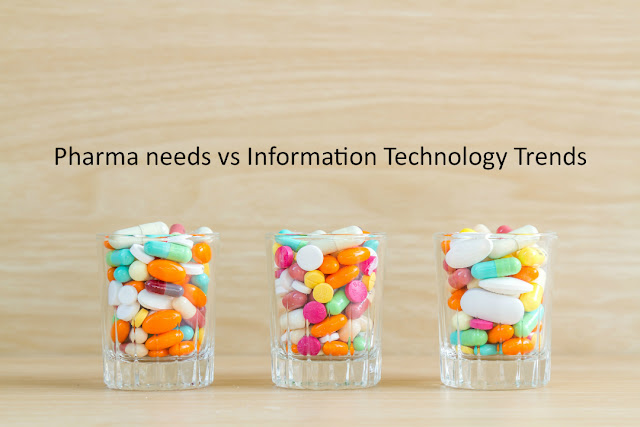Pharma needs vs Information Technology Trends
The Indian pharmaceuticals market increased at a Compound Annual Growth Rate (CAGR) of 17.46 % in 2015 from US$ 6 billion in 2005 and is expected to expand at a CAGR of 15.92 % to US$ 55 billion by 2020. In terms of world standings, the domestic pharmaceutical industry stands 4th in terms of volume and 13th in value terms. The higher-ranking in value terms could also be musing of the low prices at which medicines are sold in the country. According to the IBEF report, “By 2020, India is likely to be among the top 3 pharmaceutical markets by incremental growth and 6th largest market globally in absolute size”, also highly organized sector, a number of medicine companies promoting their operations in India.
Biopharma companies have built up Good Manufacturing Practices (GMP) compliant facilities for the manufacture of different dosage forms. In addition to having GMP, WHO, several Indian companies have also been obtaining plant approvals from international regulatory agencies like US FDA, UKMHRA, TGA, MCC -SA, ANVISA-Brazil.
Small and medium enterprises (SMEs) account for around 80% of the production in terms of volume and 40% by value. Key pharma companies are located primarily in the western region, followed by the south.
An extremely fragmented industry, where, the Indian pharmaceutical industry is estimated to have over 12,000 production units, around 8-10 thousand units manufacture formulations , while rest of them are involved in bulk drug production. Small and Medium enterprises account for around 80 % of the production in terms of volume and 40% by value.
Drug companies need to maintain with their invariably varying industry dynamics as to last out practicable and competitive. Medicine companies confront the challenges at the same time reducing costs, increasing revenues, bettering operational efficiencies, squinching drug pipelines, patent expiration, bringing new medicines to the market faster, bringing down supply chain costs, aiming brand awareness and patient loyalty, abidance with regulatory requirements.
Click here to Continue Reading
For more updates visit HarNeedi.com
Biopharma companies have built up Good Manufacturing Practices (GMP) compliant facilities for the manufacture of different dosage forms. In addition to having GMP, WHO, several Indian companies have also been obtaining plant approvals from international regulatory agencies like US FDA, UKMHRA, TGA, MCC -SA, ANVISA-Brazil.
Small and medium enterprises (SMEs) account for around 80% of the production in terms of volume and 40% by value. Key pharma companies are located primarily in the western region, followed by the south.
An extremely fragmented industry, where, the Indian pharmaceutical industry is estimated to have over 12,000 production units, around 8-10 thousand units manufacture formulations , while rest of them are involved in bulk drug production. Small and Medium enterprises account for around 80 % of the production in terms of volume and 40% by value.
Drug companies need to maintain with their invariably varying industry dynamics as to last out practicable and competitive. Medicine companies confront the challenges at the same time reducing costs, increasing revenues, bettering operational efficiencies, squinching drug pipelines, patent expiration, bringing new medicines to the market faster, bringing down supply chain costs, aiming brand awareness and patient loyalty, abidance with regulatory requirements.
Click here to Continue Reading
For more updates visit HarNeedi.com


Comments
Post a Comment